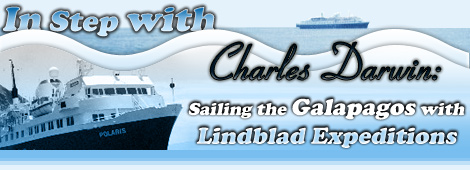 Sailing the Galapagos with Lindblad Expeditions
Sailing the Galapagos with Lindblad Expeditions
No matter how many National Geographic specials you've
seen or how many stories you've heard, nothing prepares
you for a visit to the Galapagos Islands. Whether swimming
only inches away from sea lions or sidestepping hundreds
of marine iguanas stretched out in the sun, these unique
islands are best visited with a well-established expedition
company that can offer insight and access. Amongst the
many options sailing the Galapagos, there are none better
than Lindblad Expeditions and the 80-passenger ms Polaris.
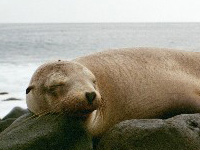 |
Founded by Sven Olof Lindblad, the son of Lars-Eric
Lindblad who pioneered expedition-style cruising, Lindblad
Expeditions employs the best naturalists and provides
them the best tools to create the most organized and
educational cruise possible. Sailing everywhere from
Antarctica to the Columbia River, Lindblad is deeply
committed to environmental conservation and ecologically
sensitive tourism and has formed strong partnerships
with National Geographic and the World Wildlife Fund.
Over the years they have built a large base of loyal
passengers who, like the infinitely curious Charles
Darwin who made these islands famous, want to see, do
and learn as much as possible.
This mentality was evident from our first day, which
had us embarking the Polaris by 10AM and going ashore
for our first expedition only a few hours later. Striking
off in a Zodiac, we explored a series of quiet lagoons
where mangroves and cactus live side by side and we
were delighted with shockingly close sightings of land
iguanas, sea lions, herons, sharks and large sea turtles.
Our naturalist, however, urged us not to take photographs
since we would see more and get closer throughout the
week.
He was proven right the next morning when we went ashore
on Espanola. Covering our landing were numerous sea
lions lethargically draped across our path, and as we
stepped around them they looked at us with only a casual
indifference. Just a few feet beyond, we were again
blocked by a jumble of prehistoric-looking marine iguanas.
It was immediately obvious that we were the ones who
had to make way for the animals, as they were not going
to move for us.
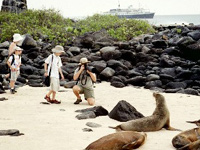 |
Visiting
nine islands in seven days, we saw a wide variety of
landscapes and animals and against my expectations;
I found the birds to be some of the most appealing creatures.
Being able to walk up to and observe hundreds of them
from close range made bird watching far more interesting
than in other areas where it usually involves searching
for one elusive feather hidden behind branches 200 feet
away.
Most endearing were the comical blue footed boobies,
and walking through a vast colony of them, we were surrounded
by an amusing juxtaposition of sound and motion as they
lifted one foot, bent their wings and whistled shrilly
during their mating dance as if they were in a Monty
Python skit.
Perhaps the highlight for me, however, was sharing a
beach not with tourists but with sea lions. Curious
babies occasionally waddled up to us and sniffed around
our face before crawling onto our stomachs and lying
down for a few moments. Sea lions were equally exhilarating
in the water- streamlined and sleek; they suddenly appeared
from nowhere and shot by us before coming back and twisting,
turning and darting around us. Coming face to face with
our snorkel mask, they would teasingly veer off when
only inches away, and other times simply stare at us
as if in an invitation to play. They seemed particular
happy when we dove and, imitating their actions, blew
bubbles for them to swim through.
Our days were often structured the same, with core activities
of swimming, walking or going for a ride in the Zodiac
repeated daily. What we saw each day would vary, however,
and we kept busy from morning till night. Starting as
early as 6AM with an optional wake-up call, days often
began with a pre-breakfast hike or zodiac ride, with
most passengers choosing to participate in the early
morning revelry.
After breakfast, we climbed into the Zodiacs and started
our morning excursion, perhaps looking for wild giant
tortoises or snorkeling with a feeding sea turtle while
sharks coolly swam past. Seeing the animals up close
and in the wild brought us a simple joy and always left
us exhilarated. This was not the distant nature that
you find on Alaska but rather a close up, personal interaction
that challenged your conventional ways of looking at
human-animal relations.
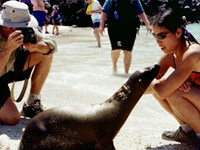 |
Because the islands are 97% national park, regulations
mandated that we stay at all times with one of our six
Lindblad naturalists. Despite hearing the same questions
each week from a new set of passengers, their intense
enthusiasm for the islands and the animals never waned,
and they seemed as excited as we were to see the short
eared owl or a pair of Bryde's whales. While each guide
had a tremendous amount of general knowledge on the
islands, they also had their own specialty. By having
an ornithologist, a geologist, and an "Underwater
Specialist" amongst other specialties onboard,
we benefited from a greater knowledge base and heard
each of them talk on their particular subject over the
dinner table or in an afternoon lecture.
The naturalists were only part of the equation, however,
as the Polaris was equipped with several tools for learning.
Video microscopes projected microscopic images of brine
to aid in a discussion of whales' feeding habits, and
if any whales were seen, a hydrophone could be dropped
in the water to broadcast their songs throughout the
ship. The guides used an underwater camera and a splash
cam to film sea lions or sharks during our swims and
would show the footage that night. For going ashore,
a fleet of sturdy but nimble Zodiacs was used, with
the expedition leader briefing everyone whether it will
be a wet landing on the beach or a dry landing on shore.
After lunch, and a brief but welcome siesta, it was
time for our afternoon excursions. With a wide variety
of ages onboard, Lindblad divided the excursions into
different activity levels. When snorkeling, experienced
swimmers went off the Zodiacs to deepwater sites, while
those less confident went off the beach or used the
glass bottomed boat to see the undersea world. Walks
ashore were also divided into varying lengths, and for
those who didn't want to walk at all; longer Zodiac
rides surveying the coast were arranged. Two SCUBA dives
were available for those who wished to see seahorses
or hammerhead sharks, and a bike ride to a restaurant
where Lindblad arranged lunch for us one day was offered
to those passengers feeling particularly fit.
While most passengers tended to be age 50 and up, almost
all were active and negotiated the occasionally tricky
transfer between the ship and the Zodiac with ease.
Lindblad encourages younger passengers as well, and
on our sailings, in addition to a few 30 and 40 year
olds, there were families onboard with their kids who
never grew bored of the sea lions or the swimming. Special
family sailings in the summer and in the holidays offer
extra activities for kids, but they are welcomed year-round.
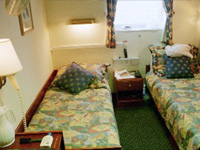 |
Just before sunset we were all onboard in time to shower
and grab a drink on the ship's teak deck before the
nightly Lindblad tradition of "Recap." Gathering
everyone in the lounge, the naturalists would talk about
the day's experiences and then give a short presentation
varying from the geological history of the islands to
a guest speaker from the Charles Darwin Research Center.
After dinner activities included videos or a gathering
on a darkened deck to identify with a laser pointer
the most constellations we'd ever seen. By 10PM most
passengers went straight to bed tired but enthused.
Happily, there was enough time built into our schedule
to recoup and enjoy the considerable comforts of the
ship. After a 40-year career that included decades of
worldwide cruising, the Polaris has settled in to year-round
Galapagos sailings for the last phase of her career.
Cozy and charming, she is well maintained and full of
nautical character after her many years of exploring
and the navigation bridge was always open for interested
passengers. With a simple lounge, an intimate library
and an attractive, wood paneled dining room, the atmosphere
onboard was casual and never required any dressing up.
Average cabins are snug, as is common on expedition
ships, but attractive and with ample storage. A masseuse
tends to a small gym and spa and leads stretching at
sunrise on the top deck. In typical Lindblad creativity,
the spa offers a small anchored boat with a glass bottom,
allowing you to be massaged outdoors while peering at
the marine life below.
Equally delightful was the ship's memorable Ecuadorian
dishes. 90% of the food came from either the islands
or mainland Ecuador, ensuring the locally caught fish
such as Galapagos Steamed Wahoo in Coconut Sauce or
the showcased fruit and juice of the day would be fresh.
A traditional Sunday Ecuadorian lunch consisted of a
huge spread of Llapingachos (Potato Patties with cheese
and peanut butter sauce), Mote Pillo (corn cooked in
milk and eggs), Lechon Hornado (suckling pig roasted
in beer and mustard) and Ceviche Mixto (seafood marinated
in lemon and tomato juice).
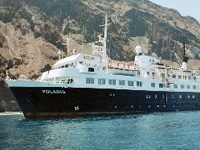 |
The
Polaris |
While my general philosophy is the smaller the ship
the better for expedition cruises, I found that Lindblad's
resources, efficiency and comforts made it the best
choice despite smaller vessels that carried as little
as 14 passengers. The ship walked the line perfectly
between offering comfort without being luxurious and
still provided a sense of exploration and excitement.
By the end of the week, I had almost come to take the
islands for granted until I was instantly reminded how
removed I was from New York City. Overhearing a teenage
passenger explaining to an Ecuadorian crew member, "They
call this an I-Pod, " I knew that the inevitable
march of time seemed to have softened in the Galapagos.
With prehistoric looking creatures all around, it didn't
take much imagination to see Darwin climbing the volcanic
peaks or studying the ancient marine iguanas stepping
onto the rocks after swimming. Different eras have fused
together in the islands, and no doubt Darwin would be
happy to see this wonderful laboratory was still much
the same. I also feel confident that if he was around
today, he couldn't help but to choose to sail onboard
the Polaris, no doubt as excited and enthralled as the
rest of us.
If
You Go: |
Lindblad
Expeditions operates six small ships that literally
span the globe, and recently introduced the Islander,
a smaller, more modern ship to compliment the
Polaris in the Galapagos. Visit the company's
extensive website at www.expeditions.com to search itineraries, read about the company's
conservation efforts and view "Daily Expedition
Reports" sent back each day from the fleet.
For more information, call 1800-EXPEDITION. |
|